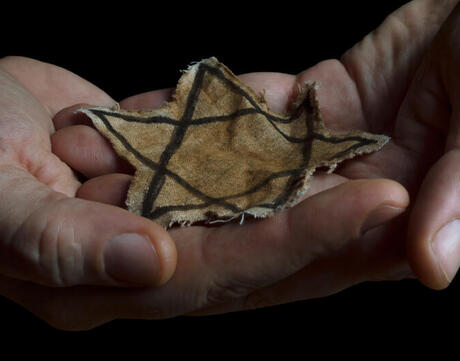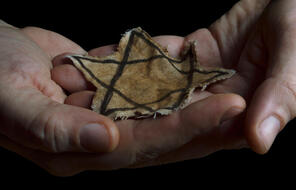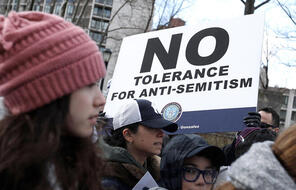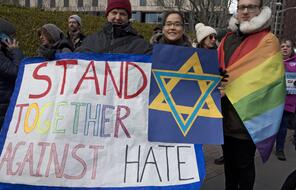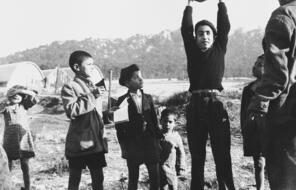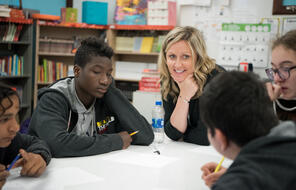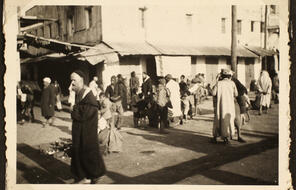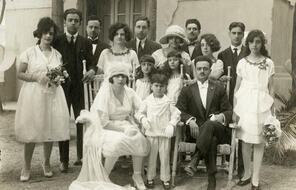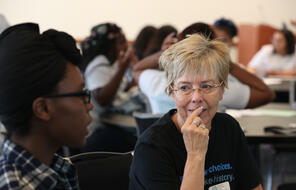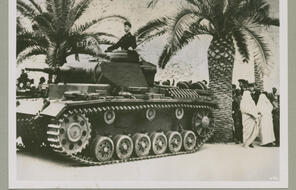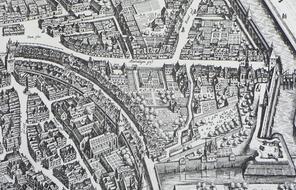This activity allows students to conduct a deeper exploration into the nuances and boundaries between using what we have learned about the Holocaust to inform our responses to current events and using the Holocaust to make comparisons about human suffering or a provocative political point.
Distribute copies of the two excerpts and ask students to closely read the first excerpt from the US Holocaust Memorial Museum, underlining or highlighting phrases where the writer Edna Friedberg names the motivations for Holocaust analogies, the dangers of making these analogies, and the impacts they have on people. The Annotating and Paraphrasing Sources strategy might be helpful here. Once students have finished reading, they should discuss the questions below the excerpts in small groups of 3–4 students.
Excerpt 1:
This excerpt is from the United States Holocaust Memorial Museum press release “Why Holocaust Analogies are Dangerous,” written by Edna Friedberg.
. . . The Holocaust has become shorthand for good vs. evil. . . . And the current environment of rapid fire online communication and viral memes lends itself particularly well to this sort of sloppy analogizing. Worse, it allows it to spread more widely and quickly.
This oversimplified approach to complex history is dangerous. When conducted with integrity and rigor, the study of history raises more questions than answers. And as the most extensively documented crime the world has ever seen, the Holocaust offers an unmatched case study in how societies fall apart. . . . It is more than European or Jewish history. It is human history.
. . .
It is all too easy to forget that there are many people still alive for whom the Holocaust is not “history,” but their life story and that of their families. These are not abstract tragedies on call to win an argument or an election. They carry the painful memories of the brutal murder of a cherished baby boy, the rape of a beloved sister, the parents arrested and never seen again.
As the Holocaust recedes in time, some Americans (and Europeans) are becoming increasingly casual and disrespectful to the mass murder of millions. More dangerous, today the internet disseminates insensitive or hateful remarks with unprecedented ease and influence. Online discussions tend to encourage extreme opinions; they allow people to live in echo chambers of their own ideologies and peers. Weimar Germany — the period between the First World War and the Nazi rise to power — is an exemplar of the threats that emerge when the political center fails to hold, when social trust is allowed to erode and the fissures exploited.
Quality Holocaust education may have the potential to bridge some of the divides our nation is experiencing. It enables people to pause. To step away from the problems and debates of the present. To be challenged by this catastrophic event of the past. That is what good history education does. It doesn’t preach. It teaches. It engages at a personal level. It promotes self-reflection and critical thinking about the world and one’s own roles and responsibilities. That engagement is lost when we resort to grossly simplified Holocaust analogies. And it demeans the memory of the dead.
. . .
Comparing and categorizing are natural human impulses. We all use categories and analogies to navigate through life. But the nature of Nazi crimes demands that we study the evidence, alert ourselves to warning signs, wrestle with the world’s moral failure. When we reduce it to a flattened morality tale, we forfeit the chance to learn from its horrific specificity. We lose sight of the ordinary human choices that made genocide possible.
Careless Holocaust analogies may demonize, demean, and intimidate their targets. But there is a cost for all of us because they distract from the real issues challenging our society, because they shut down productive, thoughtful discourse. At a time when our country needs dialogue more than ever, it is especially dangerous to exploit the memory of the Holocaust as a rhetorical cudgel. We owe the survivors more than that. And we owe ourselves more than that.
Reflect:
- Why might people object to using symbols associated with the Holocaust to draw attention to contemporary political causes?
- What are the dangers of seeing an historic event as only a symbol, rather than an actual concrete atrocity that happened to real people, orchestrated by real people?
- Why does Friedberg think that the internet makes it easier for “careless Holocaust analogies” to spread? What other examples can you think of where inaccurate information has gone “viral” or spread online?
- How do you think using Holocaust references can “shut down productive, thoughtful discourse”?
- What role might Holocaust education play in determining whether we make careless comparisons or thoughtful connections to the Holocaust, according to Friedberg?
Excerpt 2:
This excerpt is from an op-ed by Waitman Wade Beorn published in the Washington Post.
. . . [S]ome scholars have suggested that the Holocaust as a historical event is unique and therefore incomparable to any other events, past or present.
Is it, though? Can we truly never compare the Holocaust to events in modern politics? . . . If we truly adhere to the oft-intoned “Never Again,” then we also bear the responsibility of helping others recognize when “again” is now. Shunning comparisons misses an opportunity to mobilize important history for the public good.
. . . [C]urrent events do not have to mirror historical ones precisely or in severity to benefit from historical reflection.
. . .
Similar arguments were marshaled against comparing the Holocaust to any other genocide, yet there is a growing, rigorous field of comparative genocide studies that does just that. It recognizes that all genocides are unique in their own historical contexts but that all often have elements in common that are instructive for both understanding the past and interpreting the future. Perhaps what we need is not fewer Holocaust comparisons but more comparisons with other genocides.
. . .
Many of the elements of the Nazi remaking of Germany into a fascist state are missing or unlikely to arise in the United States. … Conversely, no genocide begins with mass killing. There is no reason that historical comparisons must immediately center on the Final Solution, the murder of Jews. After all, the Nazis themselves did not begin with this solution in mind to their imagined problem. They pursued other options, none of which were benign but none of which demanded the physical extermination of Jews. Genocides — and dictatorships, for that matter — do not spring into existence. Rather, they begin incrementally, with authoritarianism, racism, ethnic myths and dehumanizing language, among other things. This is where Holocaust comparisons can and should be made.
Reflect:
- Holocaust survivor and human rights advocate Eli Wiesel often stated that he never compared anything to the Holocaust.
Wiesel avoided historical comparisons because historical events are unique. However, Beorn makes the argument that appropriate comparisons can and should “mobilize important history for the public good.” How do you think learning about the past can help people to better understand current events? How is learning from the past different from “using” the past in a way that distorts or trivializes it?
- What resources will you use to determine whether a Holocaust reference is a problematic comparison or a valid connection to the present?
